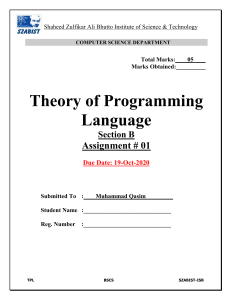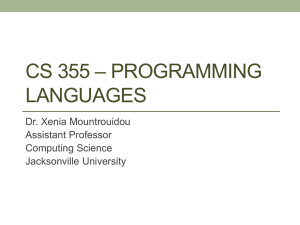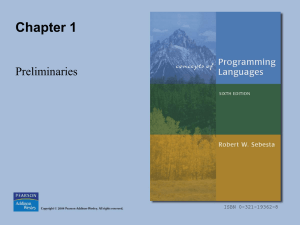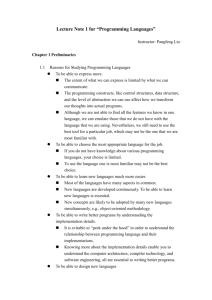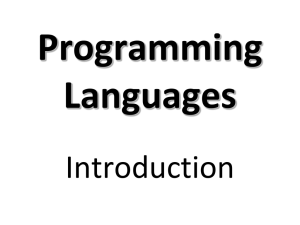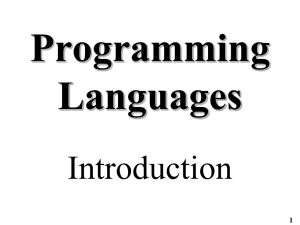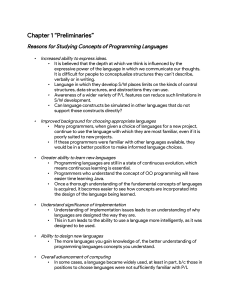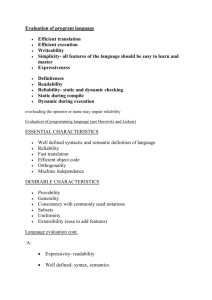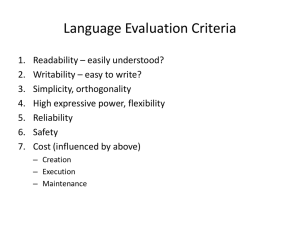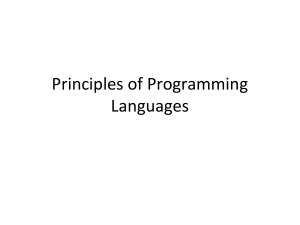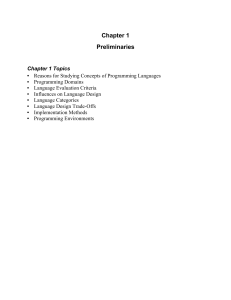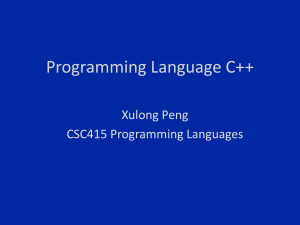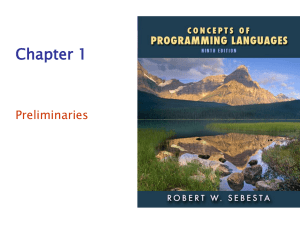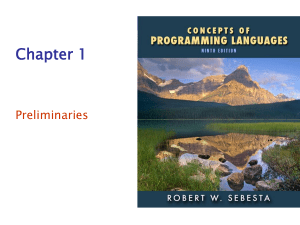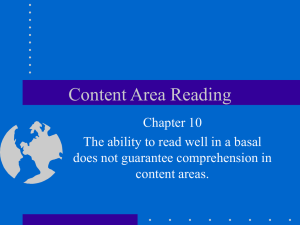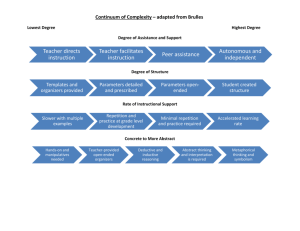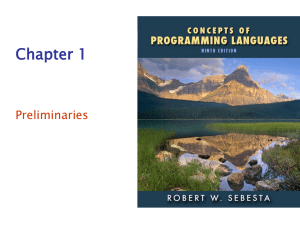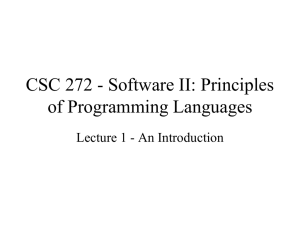Review1_kreidezj_AbbreviatedReview2pmClass
advertisement
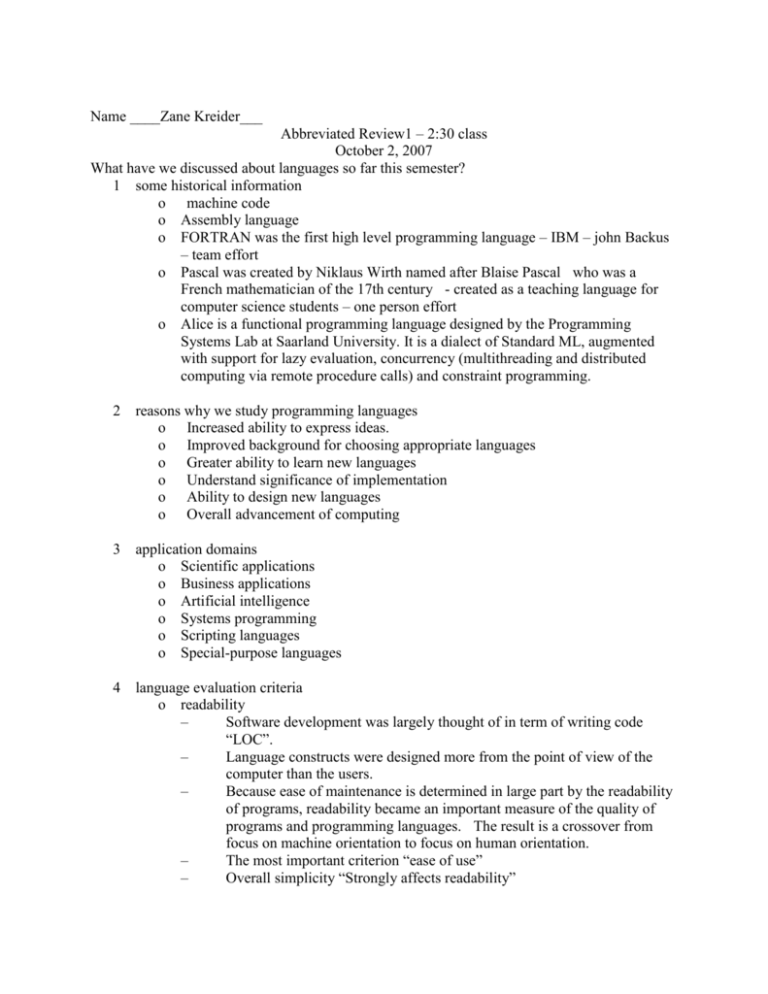
Name ____Zane Kreider___ Abbreviated Review1 – 2:30 class October 2, 2007 What have we discussed about languages so far this semester? 1 some historical information o machine code o Assembly language o FORTRAN was the first high level programming language – IBM – john Backus – team effort o Pascal was created by Niklaus Wirth named after Blaise Pascal who was a French mathematician of the 17th century - created as a teaching language for computer science students – one person effort o Alice is a functional programming language designed by the Programming Systems Lab at Saarland University. It is a dialect of Standard ML, augmented with support for lazy evaluation, concurrency (multithreading and distributed computing via remote procedure calls) and constraint programming. 2 reasons why we study programming languages o Increased ability to express ideas. o Improved background for choosing appropriate languages o Greater ability to learn new languages o Understand significance of implementation o Ability to design new languages o Overall advancement of computing 3 application domains o Scientific applications o Business applications o Artificial intelligence o Systems programming o Scripting languages o Special-purpose languages 4 language evaluation criteria o readability – Software development was largely thought of in term of writing code “LOC”. – Language constructs were designed more from the point of view of the computer than the users. – Because ease of maintenance is determined in large part by the readability of programs, readability became an important measure of the quality of programs and programming languages. The result is a crossover from focus on machine orientation to focus on human orientation. – The most important criterion “ease of use” – Overall simplicity “Strongly affects readability” – – – – – – – – – – – – – – – – – – – – – – Too many features make the language difficult to learn. Programmers tend to learn a subset of the language and ignore its other features. “ALGOL 60” Multiplicity of features is also a complicating characteristic “having more than one way to accomplish a particular operation.” Ex “Java”: count = count + 1 count += 1 count ++ ++count Although the last two statements have slightly different meaning from each other and from the others, all four have the same meaning when used as stand-alone expressions. Operator overloading where a single operator symbol has more than one meaning. Although this is a useful feature, it can lead to reduced readability if users are allowed to create their own overloading and do not do it sensibly. Orthogonality Makes the language easy to learn and read. Meaning is context independent. Pointers should be able to point to any type of variable or data structure. The lack of orthogonality leads to exceptions to the rules of the language. A relatively small set of primitive constructs can be combined in a relatively small number of ways to build the control and data structures of the language. Every possible combination is legal and meaningful. Ex: page 11 in book. The more orthogonal the design of a language, the fewer exceptions the language rules require. The most orthogonal programming language is ALGOL 68. Every language construct has a type, and there are no restrictions on those types. This form of orthogonality leads to unnecessary complexity. Control Statements It became widely recognized that indiscriminate use of goto statements severely reduced program readability. Basic and Fortran in the early 70s lacked the control statements that allow strong restrictions on the use of gotos, so writing highly readable programs in those languages was difficult. Since then, languages have included sufficient control structures. The control statement design of a language is now a less important factor in readability than it was in the past. Data Types and Structures The presence of adequate facilities for defining data types and data structures in a language is another significant aid to reliability. o writability – It is a measure of how easily a language can be used to create programs for a chosen problem domain. – Most of the language characteristics that affect readability also affect writability. – Simplicity and orthogonality – A smaller number of primitive constructs and a consistent set of rules for combining them is much better than simply having a large number of primitives. – Support for abstraction – Abstraction means the ability to define and then use complicated structures or operations in ways that allow many of the details to be ignored. – A process abstraction is the use of a subprogram to implement a sort algorithm that is required several times in a program instead of replicating it in all places where it is needed. – Expressivity – It means that a language has relatively convenient, rather than cumbersome, ways of specifying computations. o robust/reliability – A program is said to be reliable if it performs to its specifications under all conditions. – Type checking: is simply testing for type errors in a given program, either by the compiler or during program execution. – The earlier errors are detected, the less expensive it is to make the required repairs. Java requires type checking of nearly all variables and expressions at compile time. – Exception handling: the ability to intercept run-time errors, take corrective measures, and then continue is a great aid to reliability. – Aliasing: it is having two or more distinct referencing methods, or names, for the same memory cell. – It is now widely accepted that aliasing is a dangerous feature in a language. – Readability and writability: Both readability and writability influence reliability. powerful cost – Training programmers to use language – Writing programs – Compiling programs – Executing programs – Language implementation system “Free compilers is the key, success of Java” – Reliability, does the software fail? – Maintaining programs: Maintenance costs can be as high as two to four o o o times as much as development costs. – Portability “standardization of the language” – Generality (the applicability to a wide range of applications) ease of use 5 language translation methods – preprocessors – IDES – compilers – interpreted 6 language paradigms o Imperative – Central features are variables, assignment statements, and iteration – C, Pascal o Functional – Main means of making computations is by applying functions to given parameters – LISP, Scheme o Logic – Rule-based – Rules are specified in no special order – Prolog o Object-Oriented – Encapsulate data objects with processing – Inheritance and dynamic type binding – Grew out of imperative languages – C++, Java o Procedural – Machine, Assembler o Event-Driven – Flash, Flex 7 basic statements o output o input o assignment o iteration o selection 8 ways of describing languages – grammars – syntactical design – BCNF – rule sheets – compiler dependant – – – recognizers intrinsic static semantics 9 special words – key words used by language – key words used by compiler – types – const – #define 10 data types o simple types · integer · real o double precision · character · Boolean o Structured types · String · Array · Complex · record 11 built-in functions – packages – utilities – print spooling – com connections 12 subprogram types o functions return A single value o one which returns multiple values or none at all – returns values through the parameter list 13 parameter passing modes o Pass by reference o Pass by value 14 Languages (we have covered) o Cobol o Alice o Fortran o Pascal o Java
